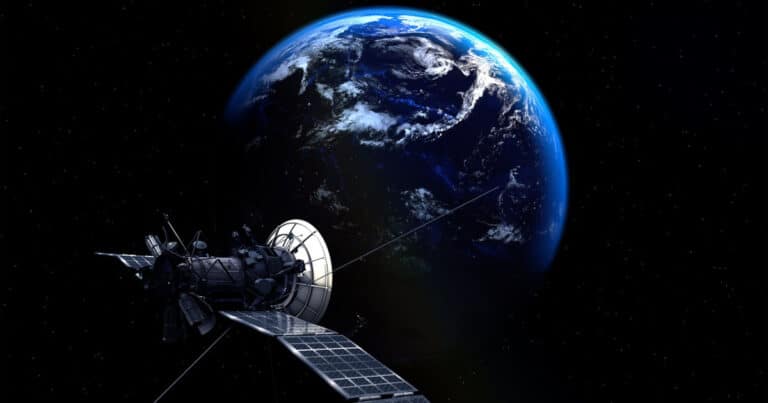By Elisheva Malomet – The hot button topic of climate change has been in the public sphere, and many are concerned about drastic changes they are witnessing. The evidence of climate change in the form of global warming is significant and is measured in many ways.
In the past few years, there has been an increase in the temperature on earth. This is a problem because it means that there has been an extreme shift in Earth’s climate system and that the changes are faster than ever before.
In this post, I will discuss how we measure climate change, and how data collection provides a big picture of the changes we are experiencing. The evidence for global warming comes from many different sources that measure temperatures or the effect of temperatures. These sources all point to one conclusion: climate change is happening now, more than ever before.
Satellites Provide Climate Data
Satellites that orbit Earth collect data on the entire globe, providing an overview for large-scale data. Satellites that orbit the earth collect pictures and data every single day that measures the changing climate. Satellites pick up on large-term patterns through the comparison of the data collection over time.
Significant changes in temperature over a long span of time have been collected by the satellites that orbit Earth. Satellites also measure and monitor ocean temperatures and currents. From this technology, we can see how sea levels have been rising by three millimeters a year around the world.
Imaging satellites help determine the changing sizes of glaciers, which is difficult to do from the ground. Satellites also help us see long-term patterns of rainfall, vegetation cover, and greenhouse gas emissions.
Paleoclimate Evidence
Paleoclimate is the ancient evidence of climates. Just like a paleontologist studies fossils of dinosaurs, the study of paleoclimatology investigates the Earth’s records of past climates and climate events. Some important tools used in researching and measuring paleoclimate are ice cores, tree rings, and ocean sediments.
Ice Cores as Climate Data
Ice cores mark significant changes in climate and the Earth’s response to an increase in greenhouse gas emissions. Ice cores are retrieved through drilling in glaciers and have frozen sections that span thousands of years.
Ice cores, taken from ancient ice sheets in the Arctic, Antarctic, and glaciers of the other continents, help scientists see how temperature changes have happened throughout Earth’s history. This is called paleoclimate data.
Air bubbles in the frozen cores indicate the saturation of gases in the atmosphere. Greenhouse gases like carbon dioxide and methane are found in the cores.
Scientists have found that the chemical composition of ice cores reveals significant increases in the levels of atmospheric carbon dioxide since the 1950s due to the burning of fossil fuels from the industrial revolution. The increasing concentration over time indicates that human emissions of carbon dioxide, and other greenhouse gases, are causing climate change.
Tree Rings as Climate Data
Tree rings, or a cross-section of a tree trunk, are most commonly used to determine the age of trees. However, they also reveal the changes in the trees’ environment during its lifespan.
Climate change is indicated in tree rings when a tree was experiencing one type of climate for much of its life and then there is a change also seen over a longer period of time.
Ocean Sediments as Climate Data
Climate scientists also study ocean sediments in relation to climate change. The sediments that are on the ocean floor got there because of currents and movement in the ocean. Some of the sediments come from the materials that melted out of icebergs and other ice formations.
Sediments and ocean cores provide a picture of what the climate of the ocean used to be like. The current sediments and carbon compound collections can be compared to what once was to get another picture of the global climate. Scientists have found that ocean sediments reveal climate change to be occurring now.
Carbon Dioxide and Climate Data
The common climate change culprit is human-caused emissions of carbon dioxide. CO 2 and other greenhouse gases are raising the earth’s temperature. These gases absorb the sun’s heat and release it gradually over time.
However, because we have inundated the earth’s climate system with an overwhelming amount of CO 2 emissions from fossil fuels, too much heat is released and then trapped within the earth’s atmosphere, causing climate change through increasing temperatures. It’s as if we have placed a blanket around the earth which traps heat and prevents it from being released into space.
Many point the finger at CO 2 because as humanity continues to industrialize and consume more, the rate at which carbon dioxide increases grows exponentially. In 2018, climate scientists found that carbon dioxide has increased at a rate 100 times faster than natural increases over the past 60 years.
Change in Global Temperature
The tools we use to measure climate change lead us to observe some alarming phenomena on our planet. Temperatures have risen dramatically both on land and in the ocean and have major effects on our world climate system.
Scientists have been recording global surface temperatures since 1880. Based on comparative data, NASA scientists have been able to conclude that 19 of the hottest years have occurred since 2000.
This rise and change in global temperature is alarming. A hotter planet means there is an increase in the global average air and sea surface temperature. Some call this increase in temperature “Global warming.” This also pertains to climate anomalies like droughts, which are becoming more common, as well as severe weather events such as floods, wildfires, heatwaves, and hurricanes.
Climate Change in the Ocean
Ocean warming is also linked to climate change, and as such is a major concern of many. The warming trend in ocean temperatures are due to the increased heat being trapped in our atmosphere from greenhouse gases, which lead to an increase in global sea surface temperature by 0.14 degrees Fahrenheit per decade since 1901. While that may not sound like much, the heating of oceans has contributed to the massive dieoffs (called bleaching) of the much of the world’s coral reefs, which are the main source of ocean biodiversity.
A 2018 National Oceanic and Atmospheric Administration (NOAA) study on changes seen at the North Atlantic Ocean’s seafloor shows that it has warmed nearly seven times faster than the global average rate since the early 2000s. This warming will have effects on all marine life but can be particularly devastating for deep-sea corals and fish species who live near or below freezing regions where they cannot survive without cold water currents that keep them cool.
Ice Melting and Climate Change
In addition to the warming of the insides of our oceans, ice sheets are shrinking, glaciers are retracting, and snow cover is reducing. All of these melting elements are contributing to a rise in sea level which is causing new problems for our changing climate system.
Greenland and Antarctic contain the world’s largest ice sheets, and they are melting. The melting ice sheets in Greenland and Antarctica, which combined make up a significant chunk of the world’s snow-covered area, has been accelerating over the past few decades due to warmer temperatures caused by climate change. Data collected by NASA reveals that approximately 427 billion tons of ice per year from 1993 to 2019 has melted from Greenland and Antarctica’s ice sheets. This is causing sea levels to rise as more water enters our oceans.
Retreating Glaciers
Glacier retreat is an increasing problem for climate change. Glaciers play an extremely important role in regulating cold climates. Due to their frozen white surfaces glaciers actually reflect the sun’s rays instead of absorbing the intense heat.
Evidence of a Glacier’s bigger impact
However, glaciers melting and retreating shed the layers of frozen surface ice and reveal darker surfaces. When exposed, these darker surfaces absorb heat. This is a dangerous way that temperatures can increase in some of the coldest places on Earth, and contribute to a positive feedback loop where heating of the earth causes more heating to occur.
As the melting process begins, the melting affects the entire structure of the glacier, causing it to melt even faster. Once glacial ice begins to break down, the interaction of meltwater with the glacier’s structure can cause increasingly fast melting. Arctic sea ice is also declining and melting in a similar way, causing sea-level rise. A tremendous amount of water is stored in Arctic sea ice.
Sea level rise as evidence of global warming
The warming of the ocean’s surface ice has been estimated to be a major cause for increased sea levels. Sea levels rise as the water expands and also from melting ice sheets, retreating glaciers and other land-based sources of freshwater (from rain or snow) that enter into the ocean. Hundreds of millions of people live in cities that are next to the ocean or seas, including megacities like Cairo, Jakarta, Guangzhou, New York City, and Lagos.
Interfaith Response to Climate Change
While the problem is certainly great, humanity is capable of curbing climate change and living sustainably. Solving the climate crisis requires everyone’s participation and awareness. This is specifically relevant for religious and faith-based communities as their outreach is extremely significant. Taking action on climate change is a moral and ethical imperative for all of us.
The faith-based community has been active in calling attention to this issue, with religious leaders engaging at the highest levels by participating in interfaith climate conferences, and the creation of coalitions to do climate work and protect creation from faith perspectives. The book Eco Bible specifically relates to the connections between many Bible verses and climate change.
As a fundamental part of many people’s lives, religion can be a key motivator by shaping values. Religion appeals not just to our intellect but to our soul—and this is where change is most needed. At this moment in history, we need a major infusion of energy specifically to help faith groups inspire behavioral change for sustainable living.
Evidence for how Religious Responses can Help
Interfaith responses to climate change can take many forms: advocacy, education, and action. The light of spirituality can spark a hopeful approach with deeper and broader effect. Here are three reasons why.
Change in Consumption
Religion can persuade people to consume in moderation as they find true satisfaction in spirituality, community, and family. Spiritual living should bring consciousness to our consumption. To rise to this ultimate challenge for human civilization, we have to raise our spiritual awareness and maturity. A person can exist at varying levels of soul awareness, but a sustainable planet will require that we learn to live and thrive at higher levels of spiritual consciousness.
Change in Expanding Knowledge
Religious teachings help instill foresight and long-term thinking. The rabbis of the Talmud taught about 1,500 years ago: “Who is the wise person? The person who can see the effect of their actions.” We must put both the present and future of our children and grandchildren first, above expanding our own standard of living. Spiritual awareness can help us recognize the link between our actions and the larger problem, while cultivating foresight, concern, and change.
There is Evidence for Hope
Finally, and perhaps most importantly, religion embodies hope. Some people—out of terror, anger, or depression—despair of our ever returning to personal and planetary balance and sustainability. Yet as Rabbi Jonathan Sacks writes, “Hope is a human virtue, but one with religious underpinnings.” Together, we can enable the next generation to inherit a thriving planet.
*Featured image source








